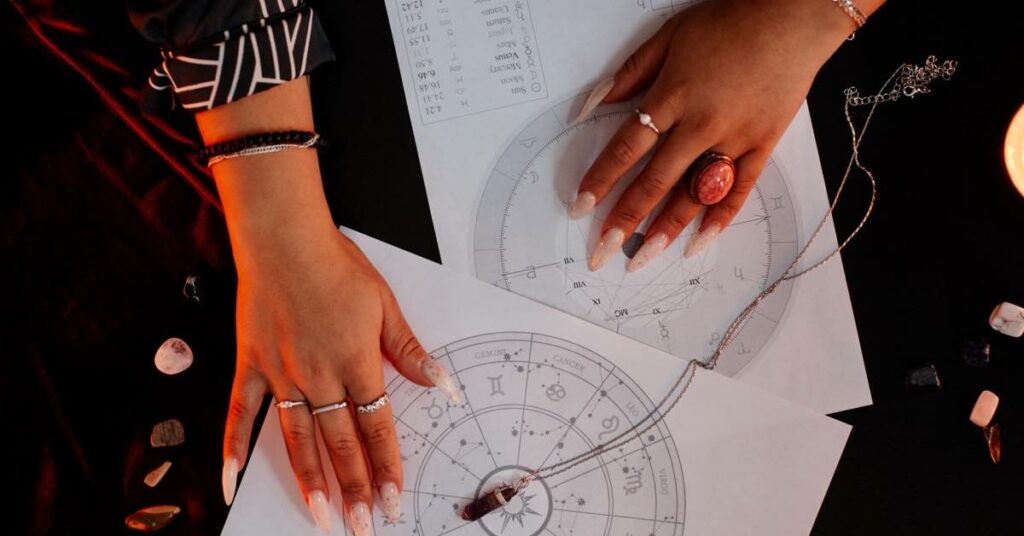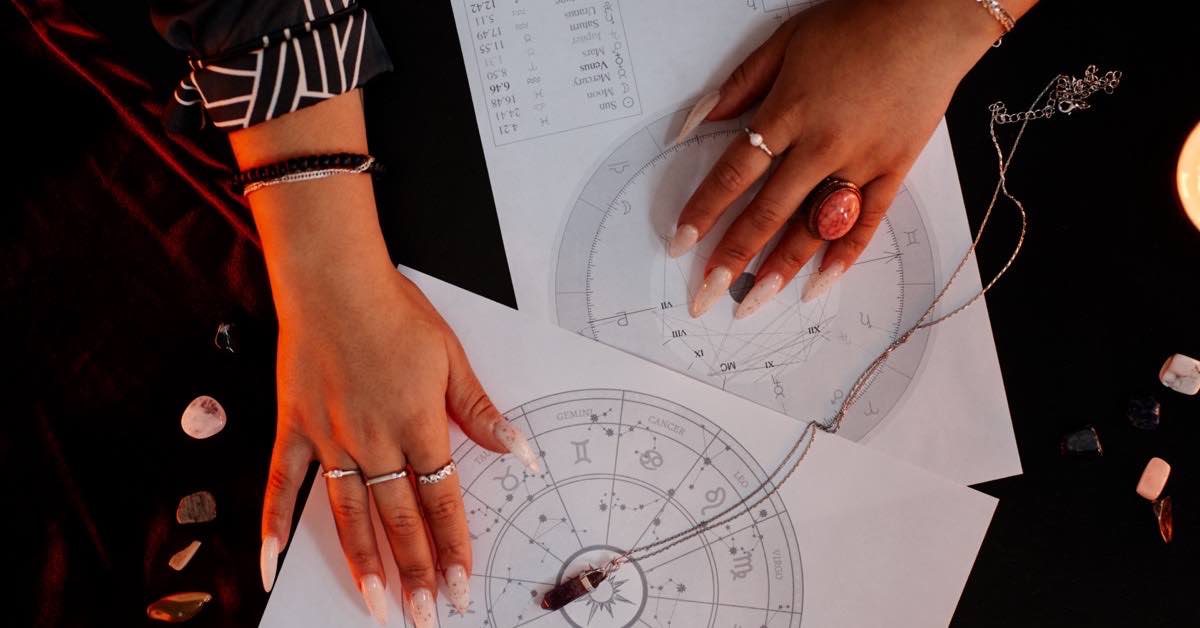Understanding the Basics of Astrological Compatibility
Astrological compatibility, often referred to as “synastry,” is a fascinating field that delves into the complexities of human relationships, exploring how people relate to each other at an intimate, psychological, and spiritual level. It is a cosmic map that scrutinizes the alignments and aspects between two individuals’ planetary bodies, revealing the strengths, challenges, and dynamics of the relationship. Synastry analysis goes beyond mere character assessment. Convinced practitioners affirm that it offers insights that have the power to deepen mutual understanding, promoting greater harmony in partnerships.

Most people, even those who are not deeply involved with astrology, are somewhat familiar with sun sign compatibility, the notion that, for instance, a Leo would ostensibly get along better with Sagittarius than a Scorpio. Yet, the labyrinth of astrological compatibility extends far beyond sun signs.
Natal chart comparison examines the planetary connections across each person’s astrological blueprint—a comprehensive blend of all the celestial bodies and points in their chart. A thorough astrological compatibility evaluation includes not just the Sun, but the Moon, Venus, Mars, and outer planets, each contributing its unique melody to the symphony of the relationship.
Decoding the Language of Astrology
In the realm of relationship astrology, understanding the intricate matrix of zodiac sign interactions is akin to learning a new language. This celestial lingua franca allows us to gain incisive insights into the compatibility factors resonating between two individuals. Just as languages consist of alphabets, words, and grammar, astrology too comprises various elements like signs, houses, and aspects. Notably, these elements work harmoniously to interpret the cosmic connections that may otherwise remain inscrutable to the human eye.
Birth chart synastry, a vital cog in the wheel of relationship astrology, offers a more detailed and dynamic perspective on compatibility. Each individual’s birth chart is essentially a celestial snapshot capturing the position of each planet at the moment of their birth. The aspect of synastry involves layering these charts, revealing intersections and alignments that may illuminate the nature of the relationship.
Thus, when we embark on the journey of decoding the language of astrology, we essentially open up a galactic Pandora’s box, abounding with insights into our inherent response mechanisms, dominant personality traits, and, most importantly, our symbiotic interactions with others.
The Role of Planets in Relationship Astrology
Astrology offers deep insights into love compatibility by examining the influence of various celestial bodies on human affairs. Specifically, relationship astrology makes use of individual birth charts and synastry—a sophisticated astrological technique. A birth chart, also called a natal chart, outlines the positions of the planets at the precise moment of an individual’s birth. On the other hand, Synastry involves comparing two natal charts to reveal the intricate dynamics at play between the individuals.
When applied methodically, synastry offers unerring insights into the strengths and potential challenges a couple might encounter and possibly even hints at shared past life experiences. Interestingly, determining astrological soulmates goes beyond the position of the sun.
The nuanced dance of the planets and how they communicate with each other within and between the charts offer clues to emotional resonance and romantic chemistry. Mars and Venus, the celestial symbols of masculine and feminine energy, respectively, play significant roles in determining compatibility, while the moon’s placement serves as a barometer for emotional links within a relationship.
Key Components of a Birth Chart
Birth charts, functioning as cosmic fingerprints, offer deep insights into our inherent traits, our potentials, and the unique ways in which we interact with the universe. One of the most significant aspects of these intricate maps is the celestial harmony, which denotes the alignment of the planets at the exact moment of our birth.
These celestial harmonies, primarily featuring Venus-Mars aspects, Sun-Moon connections, and Mercury communications, not just govern our individual personalities but also play a crucial role in shaping our relationships.
The Sun-Moon connections provide indispensable input into the compatibility factor by revealing the intrinsic needs and wants, compatibility quotient and emotional synchronizing factors between two beings.
On the other hand, Venus-Mars aspects offer insights into the chemistry and the sexual dynamics of the duo. And it is Mercury communication patterns that shed light on the intellectual rapport and the capacity for mutual understanding.
Together, these interpretations empower individuals to identify potential challenges and harmonious alliances in their relationships, fostering deeper understanding and respect for one another’s unique astrological identities.
Interpreting Aspects in Astrological Compatibility
Understanding the cosmic interplay presented in a person’s birth chart demands deep comprehension and interpretation of the relationship aspects. These aspects visually represent the mathematical angles between two points on the celestial sphere, undeniably holding a crucial significance in astrological compatibility.
It’s through this intricate weaving of astral points that the soul’s karmic bonds are understood. These bonds, believed to be formed from past lives, can provide profound insights into how different energies function together in astrological compatibility.
Factors such as the lunar nodes’ influence and ascendant compatibility further fine-tune our understanding of these divine connections. The Lunar nodes, known as the ‘Dragon’s Head’ and ‘Dragon’s Tail’ in Vedic astrology, unlock the messages of our past and future, influencing the choices that guide our spiritual journey.
Meanwhile, ascendant compatibility signifies the physical attraction and initial magnetic pull between two individuals. It informs the synergy that is observable on the surface, dictating how two individuals initially perceive and interact with each other.
Crucially, the alignment of houses within a birth chart also plays a pivotal role. It illuminates the areas of life that will be most impacted by the relationship, causing a ripple of changes that echo through every corner of our existence.

The Influence of Sun Signs on Relationships
The zodiac signs under which we are born, our Sun signs, have a monumental impact on our interpersonal dynamics. As the fundamental core of our identity, they help define our basic ego, personality, and self-expression, thus playing a pivotal role in the relationships we engage in.
While it is pivotal to note that the mere matching of Sun signs cannot be regarded as the sole determinant of a successful partnership, the shared attributes and characteristics of two individuals under the same sign or complementary signs often catalyze a strong sense of mutual attraction.
In the intriguing astrology of relationships, Sun signs act as crucial compatibility indicators and offer initial insight into the potential synergy or discord between two individuals. Along with Sun signs, planetary aspects within each person’s individual birth chart – a comprehensive map of the celestial bodies at the exact moment of their birth – add complex layers to astrological compatibility.
The interplay of these planetary placements extrapolated through the lens of birth chart synastry, allows a more nuanced understanding of how two people’s energies might blend or clash. This potent combination of Sun sign influences and planetary aspects highlights the intricate dimensionality of relationships through the insightful illumination of astrology.
Moon Signs and Emotional Compatibility
The luminous sphere that graces our night sky, referred to astrologically as the Moon, governs our emotional responses, subconscious habits, and deeply-rooted instincts. When delving into the realm of birth chart synastry, the sign in which the Moon was situated at the time of an individual’s birth creates a significant impact on the emotional compatibility between partners.
It’s akin to exploring the invisible threads that connect hearts, a phenomenon that could be described as a soul connection. More often than not, individuals with harmonious Moon signs may experience an energetic synergy, with their emotions and underlying desires resonating on the same frequency.
In the intricacies of relationship dynamics, our Moon signs can offer valuable insights. They represent our inherent emotional needs, comfort zones, and how we react when faced with hardships or crises.
As the sign that governs our deeper needs and emotional responses, the Moon speaks volumes about the potential challenges and growth opportunities that might unfold within a relationship. Thus, understanding the interplay between partners’ Moon signs can shed light on the path of their love and destiny, revealing the emotional fabric of their bond that is often elusive yet profoundly significant.
Mars and Venus: The Love Languages of Astrology
In the grand interplay of cosmic patterns, Mars and Venus have long held high esteem in the language of astrology, particularly when it comes to chart synastry focused on romantic compatibility.
The position of Mars, the warrior planet, often illustrates an individual’s propensity for assertiveness, courage, and the drive that fuels their passion and ambition. On the other hand, Venus, the planet of love, reveals a person’s innate method of giving and receiving love and equally significantly, their natural sense of aesthetics and attraction.
Delving into chart synastry insights, an astrologer deciphers an individual or couple’s interaction with these two critical planets, Mars and Venus. How they relate to, impact, or correspond to the same planets in another person’s chart exposes profound allegories of harmony, discord, magnetism, and even repulsion at times.
Therefore, the interplay of Mars and Venus in synastry unlocks vital clues to understanding each person’s deep-seated drives, desires, and love languages, essentially unveiling the secrets to innate emotional and romantic compatibility.
Calculate a Synastry Chart
Are you curious about the cosmic connections between you and your partner? Explore the fascinating world of astrological compatibility with the Synastry Chart Online Calculator. This powerful tool, provided by Astro Seek, delves into the intricate dance of the planets within both partners’ birth charts.
It not only reveals the positions of celestial bodies but also uncovers their mutual aspects, offering free astrology interpretations. Whether you’re in a long-term relationship, just starting out, or even if you’re intrigued by the magic of the stars, the Synastry Chart Calculator can provide profound insights into the dynamics of your connection. Discover the celestial symphony that shapes your relationship – try it out today and embark on a journey of self-discovery and cosmic understanding.
Questions on Birth Chart Synastry
Astrological compatibility is the study of how the positions of the stars and planets at an individual’s time of birth can influence their relationships with others. This can include friendships, business partnerships, and romantic relationships.
Astrology provides insights into individual personalities, desires, and emotional responses, which can be helpful in understanding and navigating love relationships. It does this primarily through the analysis of birth charts and the positions of planets at the time of birth.
Each planet represents different aspects of life and personality in astrology. For instance, Mars is associated with action, desire, and aggression, while Venus is associated with love, pleasure, and attraction. Their positions at the time of birth can give insights into an individual’s approach to love and relationships.
A birth chart, also known as a natal chart, includes the positions of the planets, the sun, and the moon at the time of birth. It also includes the houses, which represent different areas of life, and the aspects, which are the angles the planets make to each other.
Aspects in astrological compatibility can signify harmony or tension in a relationship. Trine and sextile aspects are generally seen as favorable, suggesting compatibility and understanding, while square and opposition aspects can indicate challenges or conflicts.
Sun signs represent an individual’s core personality, identity, and ego. They can provide a broad understanding of compatibility, as people with compatible sun signs often share similar values and outlooks on life.
Moon signs represent an individual’s emotional nature, instincts, and subconscious patterns. They can reveal how people respond emotionally within relationships, which can play a significant role in emotional compatibility.
In astrology, Mars is the planet of desire and action and represents how one asserts oneself, while Venus is the planet of love and attraction and represents how one expresses love and affection. Together, they can reveal a lot about an individual’s love language.

